How to Smoke Food on a Campfire
Have you ever wondered how to smoke your food on a campfire? It can be difficult to do if you don’t have any experience, but don’t worry! Follow these simple steps to perfect smoking every time!
How do you smoke meat over a campfire? Start smoking meat over a campfire by building a bed of coals 1" to 2" deep, the coals should have little to no flame. Position an adjustable metal grate over the coals and place the meat on the grill. Monitor the meat as it smokes to adjust the height of the grill and add more wood as needed.
Smoking food on a campfire can be a great way to both cook and preserve your food while you’re out on the trail.
[wc_toggle title=“Table of Contents” padding=“” border_width=“” class=“how-to-smoke-food-on-a-campfire” layout=“box”]
[/wc_toggle]
Smoking Food on a Campfire
Smoking meat is a great way to add flavor to your favorite meat and fish, but most people think it has to be done in a purpose-built smoker. Luckily, you can actually smoke food over a campfire pretty easily.
Cold Smoking
Cold smoking is normally used as a way to preserve meat and not really as a way to prepare food for dinner. Meat is usually brined, salted or dried as it’s cold-smoked so it can be preserved for use down the road at a later date.
Cold smoking doesn’t cook your food, it just uses the smoke (without the heat from the fire) to add flavor and help preserve it.
Hot Smoking
Hot smoking food is what most people are talking about when they just say smoking. Hot smoking is done by using very low heat and suspending or capturing the smoke around the meat to cook and flavor the meat at the same time.
You want to make sure the temperatures are high enough to cook your meat but low enough to cook it slowly. If you get the temps too high, you run the risk of overcooking or charring the meat.
Does Smoked Meat Have to be Refrigerated?
Smoking meat infuses the meat with chemicals that make it more resistant to bacteria and microbes than unsmoked meat, but it still needs to be refrigerated. You should treat it the same way that you would any other kind of cooked meat.
Smoking can be used as a way to preserve foods when you cure or dehydrate the meat. When a majority of the moisture is removed from the meat and impregnated with the formaldehyde and alcohols that smoking adds, meat and fish can last almost indefinitely without refrigeration.
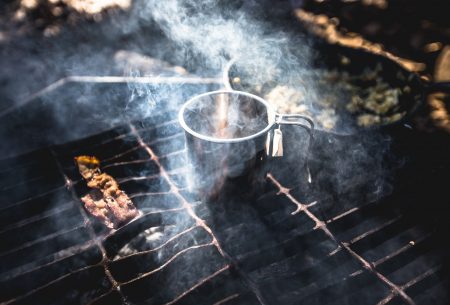
How to Set Up Your Campfire for Smoking
Smoking over a campfire is a primitive technique that is more feel than an exact science. You’re probably not going to have a meat thermometer with you (but you should if you’re planning ahead of time) and you certainly won’t have a knob on the side of your fire to control its temperature.
Gather Wood
If you didn’t bring wood specifically for smoking your food, start by gathering enough wood to keep your fire going for a few hours. It doesn’t need to be a ton of wood since you’re going to be keeping the fire very low (where it’s almost entirely coals).
Build the Fire Pit
If you already have a fire pit that you’re going to use then you can skip this step if you really want to. I like a separate fire pit sometimes if I’m not sure what wood we’ve been burning or I know that we’ve been burning wood that we don’t want to cook over.
The fire pit should be large enough for the grill that you’re going to cook on to fit over it and still have a place to add more wood when you need to. The wood should burn down next to the grill not under it. You can then move the coals from the burnt wood under the food to keep the heat where you want it.
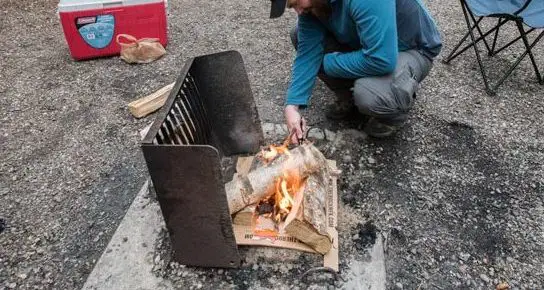
Get the Coals Ready
You can set up the grill first if you want, but I prefer to get the fire going first so you get a nice hot layer of coals in the bottom of the campfire.
Let the wood under the area that you’re going to set up your grill burn down until it’s just a layer of coals about one or two inches deep. Spreading the coals out lowers the heat and helps promote smoking.
You want little to no flames on this side of the fire pit! This is the area that’s going to be smoking your food.
The other side of your fire pit can have wood-burning down to coals or for cooking other items that need more heat.
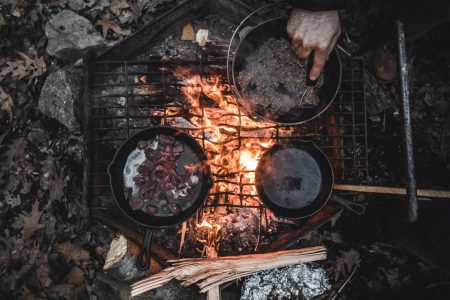
Prepare the Grill
It’s easiest to set up your campfire for smoking if you have an adjustable metal grate over it. This gives you a place to lay your meat or fish and it allows you to raise or lower your food as needed to control the temperature being applied to it.
Put your grill over the side of your fire pit with the hot coals.
[wc_box color=“primary” text_align=“left” margin_top=“” margin_bottom=“” class=“”]
This Stromberg Carlson Stake and Grille is a great option to take along with you so you always have an adjustable metal grate when you’re cooking over a fire.
[/wc_box]
If you don’t have an adjustable grill you can use rocks or bricks to adjust the height of the grill as needed.
If you don’t have a metal grill you’re going to have to get a little creative. You can build one with green branches and should be okay since they shouldn’t ever be in direct contact with the flames.
These branches could influence the taste of the food so make sure you use wood that’s good for smoking.
If you want to get really primitive you can just skewer the meat and lay the skewer above the coals.
Start Smoking!
Place your meat on the grill starting with it about 12" above the coals. Exactly how much heat is coming off the coals will depend on the design of the fire pit and the coals themselves.
Monitor the food as it smokes to make sure that the temperature stays low enough to not burn your food and high enough so it is still slowly cooking it. Add more coals or adjust the height of the grill as needed to keep the heat where you want it.
The exact time that it will take to finish cooking is going to depend on the cut of the meat and the temperatures involved. You should use a meat thermometer to determine the interior temp and make sure that it’s warm enough to make it safe to eat.
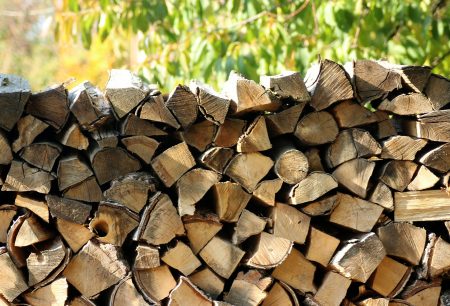
Choosing What Wood to Use When Smoking
You have two options when selecting wood to smoke your food over a campfire. You can either bring the best wood for the type of food you plan to smoke or you can collect the wood from the surrounding area.
Oak, hickory, maple, pecan, mesquite, apple, alder and cherry are all great for smoking meat and fish. Depending on where you are, any hardwood will work well.
What Kind of Wood is Best for Smoking Meat?
Meat usually has a stronger flavor than fish. It lets you use a heavier smoke than fish.
Oak is probably the best all-around choice for smoking meats. It’s stronger than apple or cherry and imparts a medium smoky flavor.
What Kind of Wood is Best for Smoking Fish?
Fish often have a more delicate flavor than meat. This means you should use a wood that creates a more gentle smoke.
Alder is one of the best woods for smoking fish. It has a mild, somewhat sweet flavor that goes really well with salmon but is good for all fish.
What Kind of Wood is the Best for All-Around Smoking?
Apple is a solid choice as a good all-round smoking wood. It adds a mildly fruity and sweet flavor that complements a wide range of foods.
What Wood Should You Not Use for Smoking?
There are a lot of different types of wood that you shouldn’t use when smoking food. Some are pretty self-explanatory and others aren’t all that obvious.
Softwoods
Don’t use wood from conifers like pine, redwood, fir, spruce, cypress, or cedar. They contain high levels of sap and terpenes that can make your food taste off and may even make some people sick.
Elm, eucalyptus, and sycamore can also give your food a weird taste.
Wood Containing Toxins
There are quite a few trees, shrubs and bushes out there that have toxins in them that will cause you to get pretty sick. Mangrove, poisonous walnut, sassafras, oleander, yet, tambootie, and laburnum are all in this category and shouldn’t be used for smoking.
Lumber Scraps
Never use lumber of any kind for smoking. You don’t have any way of knowing if it was treated, what it’s been used for, what kind of wood it is, where it was stored, or what kind of chemicals may have been on it. Any one of these things could make lumber poisonous to you and your family.
Chemically Treated Wood
Chemically treated wood is definitely not safe for smoking! Many of these chemicals are hazardous to your health and make people sick.
Lumber is the obvious source of treated wood, but pallets, furniture, and scraps from manufacturers of these products are also likely to be chemically treated. Pallets may have also been used to carry hazardous chemicals…another reason to avoid them for cooking reasons.
Wood from old orchards presents a problem as well. Many growers spray their trees with pesticides and other chemicals that can potentially impregnate the wood.
Painted or Stained Wood
Painted or stained woods will make your food taste bitter. It can also release toxic materials in the smoke which will get into your food.
Moldy Wood
Fungus or mold on old wood can make your food taste bad. It’s also possible that they’re poisonous to humans.
You can use good hardwoods that have fungus on them if you burn them down to coals first. This will remove any of the possible toxins that were there due to the fungus.
What Meat is Easiest to Smoke?
Pork butt is one of the easiest meats to smoke. It actually comes from the upper part of the shoulder and usually weights somewhere between 5 and 10 pounds.
It needs to cook for about 10 hours so make sure you have plenty of time to watch the coals and keep them going for the whole time. If you have options, hickory or pecan is great for smoking pork butt.
You can tell it’s done when the bone comes out in one gentle twist. Otherwise, cook it until the internal temperature reaches 205 degrees.
What is the Hardest Meat to Smoke?
Beef brisket is the hardest meat to smoke for most people. If it’s not prepared properly, then it ends up being tough.
Some people say that ribs are the most difficult for them. It’s really a personal thing with most people leaning toward brisket.
How do You Cook a Brisket Over a Campfire?
Cooking brisket over a campfire is pretty tough and probably not going to go great the first time that you cook it this way!
Make sure to put whatever rub that you’re going to use onto the brisket the night before. Then, before you start getting your fire pit set up, you should bring out the brisket to start warming up.
When your fire pit is set up and the coals are ready, you can start cooking the brisket. Begin with it about 12 inches above coals then raise it or lower it needed to get the brisket started cooking.
Once the brisket has some good color on it, (around an hour) you can wrap it in foil and continue to cook it. The thickest part of the brisket should be at 160 degrees when it’s done. If you like a bark on the outside, you can remove the foil about an hour before the brisket is done.
Plan for the brisket to take about 1 hour per pound to cook this way but you need to continuously monitor it to keep the temperature relatively constant and add more wood as needed. The key to this technique working well is cooking it slowly over low heat!
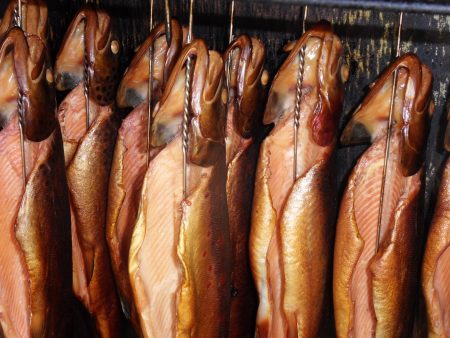
How do You Smoke Trout While Camping?
Trout is one of the most common fish in North America and it’s likely to be on the menu if you spend any time fishing while you’re out camping.
Here’s how to smoke trout to perfection:
- Start your fire just like we discussed above.
- Clean and butterfly your trout.
- Season the trout to taste. This can be as simple as adding some coarse sea salt.
- Set the grill so it’s around 12 inches from your coals and put the trout on it.
- Monitor the grill until the trout is done in 2 - 3 hours.
How do You Know When Smoked Trout is Done?
Meat really needs to hit certain temperatures to make sure it’s completely done and any parasites and diseases are killed that could be transferred to you. It’s not really the same with fish.
As long as the temperatures in the fish hit about 140 degrees, then you should be good to go.
You can test if your trout is done by using this simple trick:
Stick a fork or other piece of metal into the fish for about 10 seconds. When you pull it out, feel it to see if it’s warm or not. If the metal is warm to the touch, then your fish is done and you can stop smoking it.
The previous post Step-by-Step: How to Smoke Food on a Campfire is courtesy of: https://readylifestyle.com
Step-by-Step: How to Smoke Food on a Campfire published first on https://readylifesytle.tumblr.com
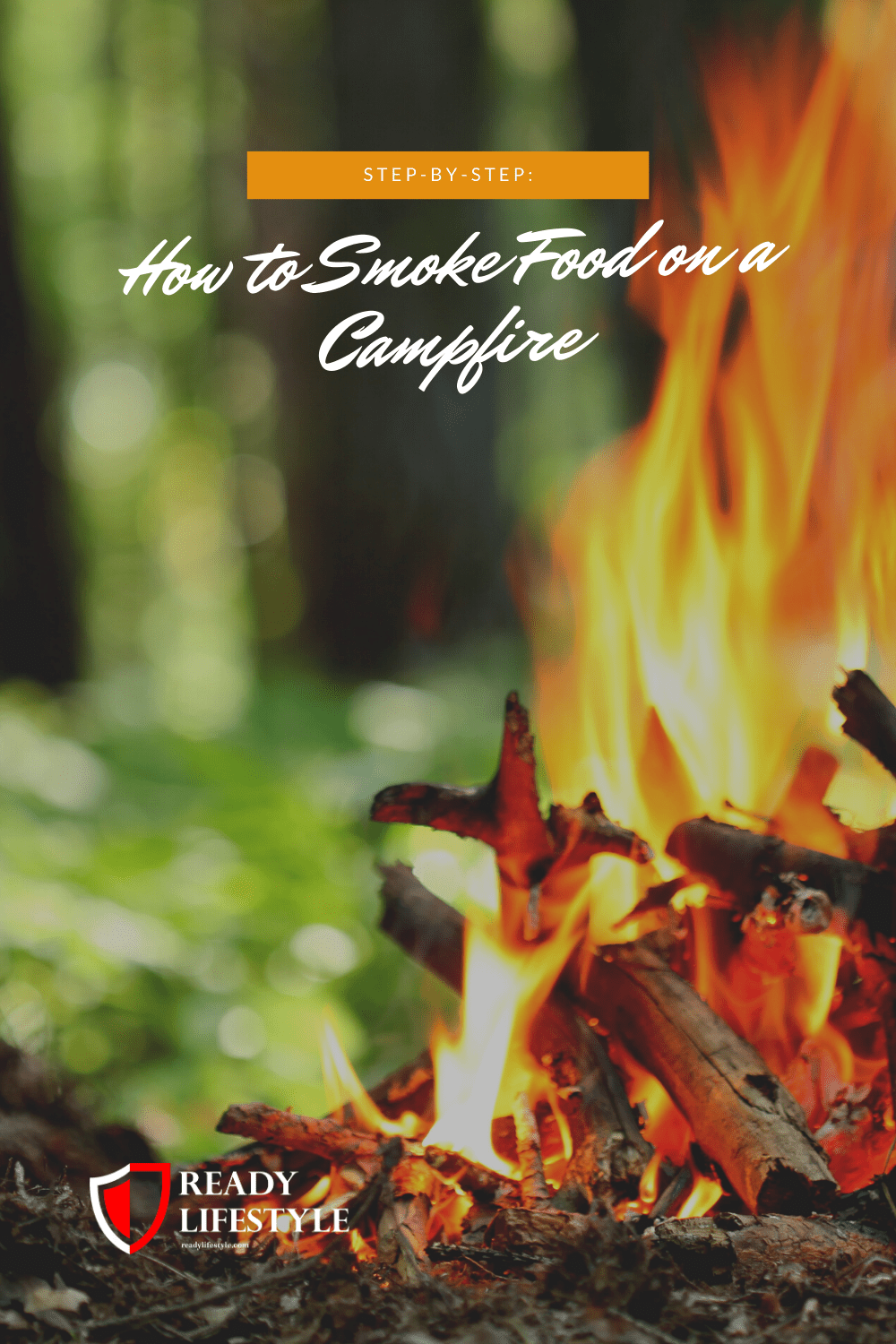
Comments
Post a Comment